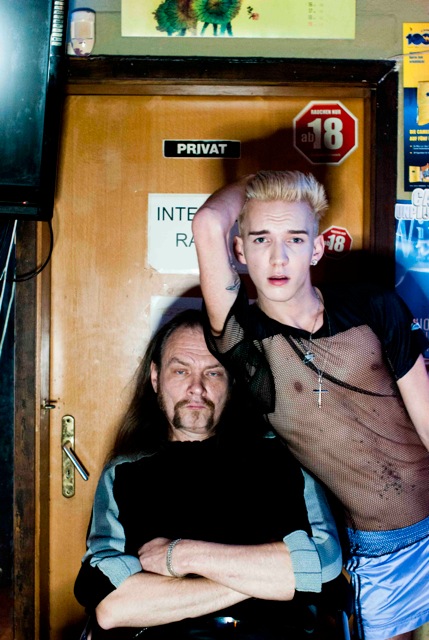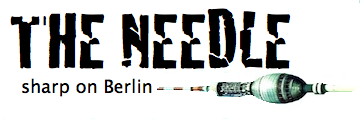240 Hours of MEAT

Actor: Dennis Kwasny. All images published with permission.
The installation MEAT, upcoming from 3-13 April 2014 at the F.I.N.D. festival, an international theatre week in the German capital (accessible to English speakers) , promises to be the most ambitious and, frankly, disturbing, artistic investigation into suspected killer Luka Rocco Magnotta ever launched, all within a studio space at the Schaubühne.
I remember that after Magnotta was picked up by Berlin police in summer 2012, at an internet café in Neukölln, almost every local hipster I knew claimed a close brush with danger. I could’ve taken him home! I was dancing at Cocktail d’Amore last night, and so was he! I walk by that internet café every day! He stood 50m from me on Grindr! I saw his profile on Gayromeo—what if I’d invited him over… then what?
This is not just paranoia, but legitimate concern given his presence was multiplied by 70 Facebook profiles, hundreds of false online identities, and a myriad of self-promoting posts. All this augments the likelihood that you really did cross his path.
And what a virtual fiend to link, like or friend! The 29-year old porn star stands accused of killing––and eating and dismembering––a Chinese student; of necrophilia; of uploading the evidence to the internet (the now infamous video, 1 Lunatic 1 Ice Pick); of sending body parts by post to be opened by unsuspecting office staff, at a Canadian political party, at an elementary school; of suffocating kittens. These horrors might be just the beginning of our discoveries.
Now permit me to use the inclusive pronoun––because only the lucky few escape a morbid fascination with death, or sex, intensified when the two find each other; fewer still are not haunted by the violent possibilities of human action, especially when enabled by the often anonymous and lonely medium of the internet. We have an alarming itch for proximity to the perpetrator, and it will soon be scratched in April when MEAT opens for business.
The title clues us to the installation’s concern with the visceral and the virtual, to the perpetrator’s bloody crimes and the airy complicity of new technologies. There will be an exact replica of the suspect’s apartment and scene of the alleged crime, and you can visit it either in person or virtually through the very social platforms Luka used––although additional hardcore material is accessible online only by password by those who have actually already visited.
All this gets me thinking as to why it feels appropriate to have MEAT open here. It’s not just Berlin’s fame as a city that dispenses with prudishness regarding sexual matters. Perhaps Magnotta haunts the public imagination of cozy Berlin because it is Europe’s safest capital, a leafy web of benign villages and the kiez. Are we so insecure as a metropolis that we crave, perversely, the legitimization of big city danger? Didn’t we enjoy being part of the international manhunt, having it end just down the block? Don’t these gruesome, and some might lament puerile and voyeuristic, enquiries on stage happen precisely here because Berlin feels so harmlos?
Or is there a more brutal truth lurking: that the story of Luka Magnotta threatens us with the actual dangers we might expose ourselves to daily. It shatters the presumed environment of trust of online dating and social networks––from Grindr to OK Cupid to match.com to Facebook, or when we pick up a stranger in the bar and take her home. Luka entered our comfort zone, and in doing so cued us to other, as of yet unrecognized, threats. And might not one additional risk be ourselves: our hyper-narcissistic self-projection enabled by often indifferent virtual media?
The Canadian authorities, refusing to promote a pathological hankering for fame, have given Magnotta very little airtime. After his extradition from Germany by military jet, he disappeared into a waiting van, and was caught up in an ongoing trial marked by publication-ban requests and political entreaties not to “celebrate his notoriety”. Certainly, publicizing Luka is, I’m well aware, an ethical Pandora’s Box. The creators of MEAT, however, have no such hesitations.
I met with the installation’s creator, Swedish architect and set designer, Thomas Bo Nilsson, formerly of Copenhagen’s SIGNA collective, and Borghildur Indridadóttir, an Icelandic actress and producer, at the Schaubühne last week. Another important voice behind the event is the set and costume designer, Julian Eicke.
“We are of course giving Luka attention, which is what he wanted”, says the director. But Thomas is unapologetic, explaining, “as an artist one of your obligations is to use your voice to discuss things. We also don’t feel it is our job to pass judgment.” Indeed, the accused has not yet been proven guilty, and will return to the courtroom this autumn. Borghildur adds, “There are many layers to Luka, and we also try to be compassionate”.
Nilsson was also at Cocktail d’amore the night Luka apparently partied there, and lives around the corner from the famed internet café on Karl-Marx-Straße. He even uses the same dating platforms as Luka. But what inspired his interest in the case were the press and police pictures of Luka’s apartment, “the direct traces of the alleged killing, but also the stories the flat told about the lonely person who lived there”.
With his team, Thomas began to collect props and furniture for the installation by going to apartments in Berlin where the possessions of deceased individuals are being given away for free via eBay.
Thomas explains, “We enter the home of someone living for 20 years without social contact or relatives, a time pocket, but also a space decorated and created for loneliness. It’s a little bit the same feeling I had when I first saw Luka’s apartment. In that way, we are re-experiencing that feeling over and over again as we collect things”.
“Hygiene and cleanliness, the things we do to stay presentable, have stopped many years ago in these places. That point of departure, where these things stop, is a big part of the show… everything that society considers being part of a healthy lifestyle was absent in Luka’s apartment. It was made for one purpose… the camera and the filthy sofa. It was a set-up for his self-creation, that led to the point of no return when he allegedly killed”.
Thomas and I speak about the connection between space, loneliness, and the crimes in the presumably harmless environment of the Schaubühne café, to the sound of spoons rattling in cups. Fame was perhaps a substitute for immortality for Luka, whose twink porn career was halted by ageing, whose apartment suggests utter emptiness and solitude. Thomas thinks, “there is a connection between being lonely and the acts. One of the things we read between the lines is his quest for immortality, not to be someone who would fade away into obscurity”.
Recreating these interactive spaces, which will occupy the entire studio at the theatre, has not been easy. They have been preparing since the beginning of the year, 14 hours a day, and collected enough material to fill three enormous storage containers. The set contains a bar, a shopping mall, an internet café, and domestic spaces, including the famed apartment. It stretches over several hundred square metres and is full of enough tricks to make every visit unique. The show itself will last 240 hours over ten days, and provides live online streaming from all its rooms. The fact that you can visit the set at any time of the night rather scares me. I’d rather not think of Luka in the early hours. It might turn out to be even more unnerving for the actors, some of whom will not leave for the duration.
This team consists of 120 collaborators, including 60 actors and 60 in the production team. The directors received originally almost 1000 applications, which were narrowed to 300, before the final cut. Rehearsal has occurred in “real spaces” throughout Berlin. Thomas tells me, “We are practicing now in character, in costume, in actual places that echo the atmosphere that we want in the show. We go to Tabasco in Schöneberg [a bar famed for male prostitution], places that can help direct the actors to deliver the right atmosphere”.
“Our rehearsal process is in different steps, one step is to create a realistic layer”, says Thomas. “This layer is later-on distorted and edited, as if it were a movie. But the first layer gives the actors such a profound feeling of reality that it permits the distortion in the second step. We are working with professional and non-professional actors, as well as so-called real people… such as go-go dancers who are also taking part in the show”.

Actors: Gregor Biermann & Dennis Kwasny.
You might wonder whether MEAT involves an age limit, and, unsurprisingly, it does: 16 years. Thomas tells me with a smile it is “Not a family show”. “No shit!” I reply. He’s already explained that they have some of the material from when Luka was a porn star. Thomas qualifies whimsically about its family content: “Although there are families in the show, it is not necessarily for families. We also include fragments from other people who surround him”. I ask whether they really do plan to include other people’s “fragments” in the installation—anything’s possible with this subject. Thomas is alarmingly coy, and laughs.
Thomas has already explained, using the metaphor of surfing the internet, that Luka Magnotta is simply the point of departure of the installation. One click leads to the next exploration, to the next, opening up rooms of discovery. You might be led from the rent boy scene of Berlin, to Grindr (a mobile phone app to link gay men by proximity), to a chat that ends with a stranger sleeping in your bed. But I am still hankering to nail this installation down, for a statement of the artist’s goals. It seems a barbarous question to ask about his “intentions”, but I go for it anyway. I’m already sharpening the blade of my “internet-narcissism is bad” thesis.
He is too elegant to make me feel like a cad: “Our aims are unimportant and if we could state them in one sentence it would be a lot of work for nothing. I choose not to answer the question, because from my experience if you give a clear answer to your aim, you start directing your audience, give them a clue for what they will look for, and the audience pays the price for that. What you choose to focus on is individual, just as our observations about Luka are coloured by how we are ourselves. Using Grindr and Gay Romeo puts me in a different relationship to him than, say, my mother”.
With this, I am intrigued whether the experience of an installation on, admittedly, such a creepy subject has changed the director’s way of using dating platforms. Luka can’t be the only auto-publicized, celebrity-seeking, alleged killer out there. Isn’t this show, when it comes down to it, really about the self-promoting and indifferent anomy of internet culture?
Thomas’ answer surprises me, “It hasn’t stopped me. Because I’m curious”.
“Curiosity killed the cat”, I answer.
“It doesn’t scare me, the opposite I’m afraid. The more we research and work with Luka, the more we follow his line of thoughts, and start to understand him. That is what is scary”.
*04/2014 Read our post-performance debriefing of MEAT here.
*This article first appeared on the FIND festival blog.
Dr. Joseph Pearson is a Canadian writer, historian and local expert on Berlin. He lectures at New York University-Berlin and is the editor of The Needle.
